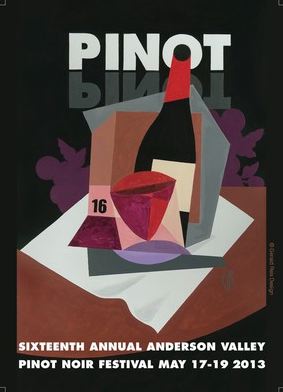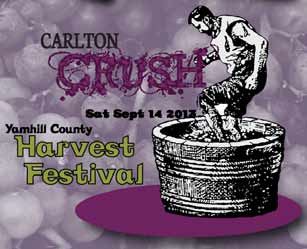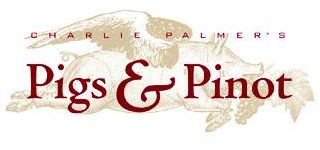Pinot Briefs
—Newsletter 9.24
World of Pinot Noir Burgundy Presentation Don Kinnan’s slide presentation from “Terroir: The
Soul of the Côte d’Or” held on Saturday, March 2, 2013, is now available for viewing on the World of Pinot Noir
website at www.wopn.com. The audio recording of Kinnan’s seminar is also available on both the World of
Pinot Noir website and Grape Radio at www.graperadio.com. World of Pinot Noir email subscribers receive a
10% discount on the French Wine Society’s new Bourgogne Master Level Program.
16th Annual Anderson Valley Pinot Noir Festival Technical Conference The schedule
of the full day Technical program on May 17n has been announced. Visit www.avwines.com for information on
the entire event which will be held May 17-19, 2013. Greg Walter of Pinot Report will discuss the current state
of Pinot Noir; Glenn McGourty, a viticulture and plant science advisor will give a report on the state of viticulture
in Mendocino County and agricultural water use in Anderson Valley; a comparative tasting of Pinot Noir Blanc
from New Zealand, Oregon and Anderson Valley will be offered; I will present a talk on Pinot Noir Suitcase
Clone “828”; Mel Knox, broker for Tonnellerie Francois Frères and Tonnellerie Taransaud, will speak on barrel
selection for Pinot Noir; a Riedel glass comparative tasting panel will follow; and a focus tasting panel with
Brad Wiley will present wines of Wiley Vineyards. The Technical conference will include a lunch in the
Fairground’s Redwood Grove including buffalo burgers and a selection of local wines.

2013 Carlton Crush Festival Registration is now open for the Carlton Crush competitions at the 2013
Carlton Crush Harvest Festival. The event will be held on September 14, 2013, to celebrate the unique culture
of Carlton and Yamhill County. Live music and entertainment, food and wine, an Artist’s market, and helicopter
rides. Registration forms for the Grape Stomp, Barrel Rolling Race and Wine Thief Relay are available on the
event’s website at www.CarltonCrush.com.

9th Annual Marin Wine Celebration An opportunity to taste newly released Marin-grown wines
including some library selections, poured by vintners and growers at the historic Escalle Winery in Larkspur.
These small lot wines are truly hand made and reflect the unique bounty of Marin County agriculture.
Participating wineries include Bailiwick Wines, Burning Bench Cellars, Couloir Wines, DeLoach Vineyards,
Dept C Wines, Dutton-Goldfield Winery, Easkoot Cellars, Kendric Vineyards, McEvoy Ranch, Pacheco Ranch
Winery, Pey-Marin Vineyards, Point Reyes Vineyards, Sean Thackrey, Skywalker, and West Wind Wines.
Saturday, May 11, 2013, from 3:00 to 7:00. Cost is $55. Visit www.malt.org.
Proposed Sta. Rita Hills AVA Expansion A petition to extend the eastern boundaries of the Sta.
Rita Hills AVA has recently been submitted to the TTB by Patrick Shabram. The Sta. Rita Hills AVA lies within
the larger Santa Ynez Valley AVA, an east-west transverse valley with a continuum of climatic and geological
features influenced by its opening to the Pacific Ocean. It spans over 31,000 acres at the far western end of
the Santa Ynez Valley and has one of the longest growing seasons and coolest climates among winegrowing
regions of California. The current and original AVA boundaries were carefully determined in 2001 by the
original petitioners based on patterns of daily oceanic fog and temperature data. The eastern boundary to the
AVA is a north-south range of hills that alters the sea fog pattern and brings an increase in daily temperatures
moving east from this boundary. In the opinion of the original petitioners and the Sta. Rita Hills Winegrowers
Alliance (SRHWA), it is imperative that the cool climate environment for winegrowing is maintained. A study of
the data in the petition submitted by Mr. Shabram will be reviewed by the SRHWA board, but at this time the
SRHWA stands by the integrity of the original and current boundaries. Visit www.staritahills.com.
Sta. Rita Hills Wineries on the Road SRHWA members will be sharing their new vintages at three
locations throughout California: April 29 at The Wine House in Los Angeles, May 13 at The Firehouse Fort
Mason Center, and May 14 at Stark’s Steak House in Santa Rosa. The evening tastings are open to the
public. Participating wineries include Cargasacchi, Cold Heaven, Clos Pepe, D’Alfonso Curran, Dragonette,
Fiddlehead Cellars, Flying Goat Cellars, Hilliard Bruce, Huber, Kessler-Haak, Lindley, Liquid Farm, Longoria,
Pali Wine Company, Rozak, Siduri, The Hitching Post, Transcendence, and Zotovich Cellars. Visit
www.staritahills.com.
2013 Pigs & Pinot Recap On March 22-23, Chef Charlie Palmer’s Eight Annual Pigs & Pinot Weekend
was held at Hotel Healdsburg and Dry Creek Kitchen. Honored guest chefs were Jose Garces, Dean Fearing,
Elizabeth Falkner, and Craig Stoll and top Pinot Noir winemakers lent their talents to raise funds for Share Our
Strength and local Sonoma County charities and organizations. The Pinot Cup Winner was the 2010 Roth
Estate Sonoma Coast Pinot Noir and the runner up was the 2011 Te Kairanga John Martin Reserve
Martinborough New Zealand Pinot Noir. The Sommelier Smackdown Winner was the 2011 Lucia Soberanes
Vineyard Santa Lucia Highlands Pinot Noir and the runner up was the 2010 Bergström Homage Willamette
Valley Pinot Noir. The Gala Dinner at Dry Creek Kitchen featured a signature creation from Palmer and the
visiting master chefs, paired with Pinot Noirs from De Loach Vineyard, Domaine A.F. Gros, Kosta Browne,
Martinelli Winery and Sea Smoke. Hotel Healdsburg’s sister property h2 Hotel offered a Swine and Wine
dinner the same night featuring some of the Bay Area’s most innovative chefs and the Pinot Noirs of Cobb
Wines and VML Winery. Join the mailing list to try to get a coveted ticket to next year’s Pigs & Pinot event:
www.hotelhealdsburg/pigsandpinot/.

Prodigal Ceases Production Steve and Mary Russell have announced that after wrestling with a
tough decision for the last two years, they decided to produce no more wine. They will be concentrating
instead on their Quinta Santa Rosa Vineyard and their bucket list. Their excellent wines are on sale at half
price at the tasting room in shared space with Standing Sun Wines, 92 Second St., Unit D, Buellton, CA.
Pinot Leaf Curl and Pinot Leaf Roll Take Their Toll Pinot leaf curl has been seen more often
in Sonoma County’s Pinot Noir vineyards during the cool vintages of 2010 and 2011. Researchers have
theorized that it is due to a nitrogen disorder that leads vines to produce the toxic compound putrescine and
seems to be related to vineyard location and low spring temperatures. Another condition, leaf roll, is due to a
virus. Sadly, it has taken its toil on the Old Vineyard at Hirsch Vineyards in Cazadero, on the far reaches of the
Sonoma Coast. 2011 was the last year for most of the Old Vineyard as yields had declined significantly.
Pinot Noir from the Rocky Mountains? A worldwide analysis of climate change and its affect on
winegrowing appeared recently in the Proceedings of the National Academy of Sciences. The study suggested
that wine production will shift to new regions as climate change makes some of the existing winegrowing
regions unfavorable. Nine major wine producing areas were studied including California. An area that may
prove suitable for winegrowing in the future is in the Rocky Mountains near the Canadian-United States border.
the analysis predicted that many California vineyards will become unproductive. North Coast grape farmers
remain optimistic about finding ways to produce premium crops if temperatures rise as the study predicts
(Press Democrat, April 11, 2013). “The work of grapevine researchers and the adaptability of farmers as well as
the region’s proximity to the Pacific Ocean will help prevent the demise of Wine Country.”
Fingertip Alcohol Scanner As reported in The Drinks Business (April 9, 2013), the AlcoSense
TruTouch 2500 was launched at the Commercial Vehicle show in Birmingham, England. The new technology
can determine a person’s level of intoxication in seconds with just a touch of a finger and is 96% accurate. The
scanner uses a near-infrared light to measure blood alcohol content in the skin through contact with an optical
pad. The system can also be used to determine the identity of the user. The TruTouch is not yet certified in the
UK. Visit www.AlcoDigital.co.uk.

2012 Record Wine Sales in United States According to The Financial ( www.finchannel.com,
April 8, 2013), wines sales in the U.S. from all U.S. states and foreign countries increased 2% from the
previous year to a new record of 360.1 million 9-liter cases with an estimated retail value of $34.6 billion.
California wine accounted for 58% of the sales. California wine shipments to all markets in the U.S. and
abroad reached 250.2 million cases. It is predicted that wine consumption in the U.S. will continue to increase
over the next decade. Chardonnay is still the most popular varietal (21% share of volume), followed by
Cabernet Sauvignon, Merlot and Pinot Gris in that order.
Direct-to-Consumer Wine Shipments The 2013 Wines & Vines and Ship Compliant Direct
Shipping Report found that the value of direct-to-consumer shipments from American wineries increased to
$1.46 billion in 2012, and was greater than the total value of U.S. wine exports. The 10% increase in sales of
direct-shipped wines continues the sales channel’s history of outpacing the growth of overall wine sales in the
U.S.. More than 2.17 million 9-liter cases of wine were shipped direct to American consumers in 2012, a 7.7%
increase over the year before. The 2013 Direct Shipping report is available free for downloading by visiting
www.shipcompliant.com/shippingreport.
Non-Sulfured Wines May Become Available According to The Drinks Business (April 16, 2013),
a company in Italy, Integrapes, is testing an antioxidant and antibacterial preservative derived from grape pips
that it believes is as effective as sulfur. In addition, the wine is said to retain more of wine’s natural aromas,
particularly the delicate floral aromas that sulfur can obscure. The compound is derived from the polyphenols
found in grape seeds and the resulting solution is then added to the must and wine at various stages of the
winemaking process. Essentially, one liter of the preservative is added to every 20 hectoliters of wine at the
end of alcoholic and then malolactic fermentation and then before bottling. The resulting wine supposedly has
the potential to age, unlike non-sulfured “natural” wines (the company producing the preservative has followed
wines for seven years). The product has been endorsed by Italy’s leading wine writer, Luca Maroni, who is
collaborating in the testing.
Why Indicate pH & TA in PinotFile Wine Reviews? You won’t see these figures in reviews
from any other wine publication, but I believe this is just as relevant as the alcohol percentage or barrel aging
regimen. It gives the consumer some valuable additional information that can be used as an adjunct to making
choices about which wines to drink. Thanks to Dan Goldfield’s Dutton Goldfield Newsletter and Gary Farrell in
his Alysian Wines Newsletter for the following explanations. Acidity is a measure of the breakdown of products
of water in solution. In other words, a small amount of water is broken down to H+ (hydrogen without its
electron, which is negatively charged, hence the positive charge here) and OH- (the oxygen keeps the extra
electron, thus the negative charge). H+ is the active agent of acidity so the higher the H+ concentration, the
more acidic the solution. pH is a measure of the strength of acidity. Since pH is the negative log of the H+
concentration, the lower the pH, the more acidic the solution. Pure water has a pH of 7. Blood is 7.2 and
bleach is 9. On the other end, coffee is about 5, lime juice is 2 and stomach acid is between 1 and 2. Wine
tends to fall between 3 and 4, but from pH 3 to pH 4 there is a tenfold reduction in H+ so this variation is
significant.
pH is a critical measurement during winemaking and ideally should be below 3.60 for sulfur dioxide to be
effective during the winemaking process. Lower pH juice ferments cleaner and produces more favorable flavor.
A higher pH will increase the chance of Brettanomyces and the growth of spoilage organisms. The average red
wine in California with a finished pH of 3.6 requires 50% more free sulfur than a finished red wine at pH 3.4 to
offer equal protection. Lower pH is associated with an intensified red wine color, lower pH wines tend to age
more slowly, and the brightness and tart balance of a wine comes from its acidity. Acidity also affects the way a
wine shows oak aging. Higher acid wine tends to show wood more slowly and changes the choices a
winemaker might make in that regard. Low acid (high pH) wines can be flat and lack freshness. Wines with
generous acidity are more likely to be crisp, vibrant and refreshing.
The other common way of expressing acidity is the titratable acidity or TA. This test measures the total of all
acids present. The perception of acidity in a wine is related to the TA and not pH. TA produces the acid
sensation in the mouth and is most critical for mouth feel. pH and TA values do not run parallel, and a wine can
have a high pH and a low TA or vice versa. However, wines with higher total acidity generally exhibit lower pH
values. Higher TA tends to make the astringency of a wine more apparent, as does higher alcohol. The
balance of TA with alcohol, which is perceived as sweet, is very important to the flavor profile of a wine.
Pinots in the Marketplace How much highly desirable California Pinot Noir is bought to sell rather
than bought to drink? Every day, I receive offers from resellers to buy Pinot Noir on the secondary market,
often with a significant markup over the original release retail price. There is a remarkable amount of Pinot
Noir for sell produced by prominent, highly regarded wineries, and I wonder how much of this wine is being
drunk? I see more resell offers for Williams Selyem Pinot Noir than any other California Pinot Noir producer,
but Kosta Browne, J. Rochioli, Rivers-Marie, Rhys and Marcassin are frequently resold as well. Much of this
resell activity stems from the fact that all these producers highly allocate their wines to mailing lists that are full,
so their is a segment of wine enthusiasts for whom their only access to these wines is to buy them on the
secondary market. The result is that some buyers on the mailing lists buy to sell, and many on the outside buy
at a premium to drink.
U.S. Dept of Health and Human Services Most Recent Data (2008) Oregon is #15
among U.S. states in per capita consumption at 4.3 gallons, California is #9 at 4.9 gallons, and District of
Colombia is #1 at 8.8 gallons. Apparently our politicians love wine.
Second Annual Passport to Pinot Russian River Valley Winegrowers (RRVW) has announced its Second Annual Passport to Pinot Barrel Tasting Weekend on June 8-9, 2013, from 11:00 to 4:00. More than 30 wineries will share exclusive offerings with ticket holders including barrel tastings, futures purchases, library tastings, food pairings, artist demonstrations and entertainment. Tickets are $65 for the weekend that includes both days. A limited number of Sunday only and Designated Driver tickets are available. For information and to purchase tickets, visit www.rrvw.org or call 877-650-3717. The documentary, "From Obscurity to Excellence: The Story of Grapes & Wine in the Russian River Valley" will be shown on June 7 at the Vintner's Inn in Santa Rosa following a wine reception. See a preview of the film at www.russian-river-valley.com. Tickets may be purchased online at www.rrvw.org/passport-to-pinot.
Memorial Weekend in Oregon Wine Country The traditional Memorial Weekend in the Wine Country will be held in the Willamette Valley May 25-27, 2013. Many Oregon wineries that are not open to the public will be hosting open houses this weekend. Hosted by the Willamette Valley Winegrowers Association, a guide is available at www.willamettewines.com or use the Mobile Wine Tour app that is compatible with all smart phones at www.WillametteWineMap.com.






